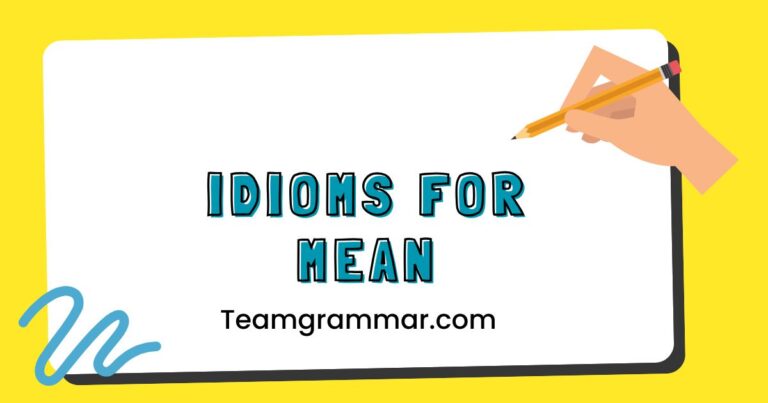47 Decoding Cat Idioms: A Comprehensive Guide for English Learners
Idioms add color and depth to the English language, making communication more vivid and engaging. Among the many categories of idioms, those featuring “cat” are particularly common and often humorous.
Understanding these idioms is crucial for grasping nuanced meanings in everyday conversations, literature, and media. This article serves as a comprehensive guide to cat-related idioms, explaining their meanings, origins, and proper usage.
Whether you’re an ESL student, a language enthusiast, or simply curious about the quirks of English, this guide will help you master these feline-inspired expressions.
Table of Contents
- Introduction
- Definition of Idioms
- Structural Breakdown of Idioms
- Types and Categories of Cat Idioms
- Examples of Cat Idioms
- Usage Rules for Cat Idioms
- Common Mistakes with Cat Idioms
- Practice Exercises
- Advanced Topics in Cat Idioms
- FAQ
- Conclusion
Definition of Idioms
An idiom is a phrase or expression whose meaning cannot be understood from the literal meanings of its individual words. Instead, idioms have a figurative meaning that is culturally specific.
They are a vital part of any language, providing a way to express complex ideas in a concise and colorful manner. Learning idioms is essential for achieving fluency and understanding native speakers.
Idioms typically involve a combination of words that, when taken individually, do not convey the intended meaning. The meaning is derived from the collective phrase and its historical or cultural context.
For example, the idiom “raining cats and dogs” does not literally mean that animals are falling from the sky; it means that it is raining heavily.
Classification of Idioms:Idioms can be classified based on their structure, grammatical form, or the type of figurative language they employ (e.g., metaphors, similes, hyperboles). Some idioms are fixed phrases, while others allow for some degree of variation.
Understanding the classification helps in recognizing and using idioms effectively.
Function of Idioms:Idioms serve various functions in communication. They can add emphasis, convey emotions, create humor, or provide a shorthand way of expressing common ideas.
They also contribute to the cultural identity of a language and its speakers. Mastering idioms allows for richer and more nuanced communication.
Contexts for Idioms:Idioms are used in a wide range of contexts, including informal conversations, formal writing, literature, and media. The appropriateness of using an idiom depends on the audience, the tone of the communication, and the specific situation.
Some idioms are more formal or informal than others, and it’s important to choose idioms that are suitable for the context.
Structural Breakdown of Idioms
The structure of idioms can be analyzed from different perspectives, including lexical, syntactic, and semantic. Lexically, idioms are composed of specific words that contribute to the overall figurative meaning.
Syntactically, idioms can follow various grammatical patterns, such as phrases, clauses, or sentences. Semantically, idioms have a non-literal meaning that is distinct from the literal meanings of their constituent words.
Lexical Structure:The words that make up an idiom are carefully chosen and contribute to the overall meaning. Changing even a single word can alter or destroy the idiom’s meaning.
For example, “let the cat out of the bag” relies on the specific words “cat,” “bag,” and “let,” and using synonyms would not convey the same idiomatic meaning.
Syntactic Structure: Idioms can exhibit different syntactic structures, such as verb phrases (e.g., “kick the bucket”), noun phrases (e.g., “a piece of cake”), or prepositional phrases (e.g., “in the doghouse”). The syntactic structure does not necessarily reflect the literal meaning of the words but rather contributes to the idiomatic meaning.
Semantic Structure:The semantic structure of an idiom involves the figurative meaning that is conveyed by the phrase. This meaning is often metaphorical or symbolic and requires an understanding of the cultural context.
For example, “to have kittens” does not literally mean to give birth to kittens; it means to be very anxious or upset.
Understanding the structural elements of idioms is essential for recognizing them and using them correctly. By analyzing the lexical, syntactic, and semantic components, learners can gain a deeper appreciation for the complexities of idiomatic language.
Types and Categories of Cat Idioms
Cat idioms can be categorized based on their meaning, usage, or the specific aspect of cats that they reference. Some idioms describe personality traits, while others describe situations or actions.
Understanding these categories can help learners use the idioms appropriately.
Idioms Describing Personality Traits
These idioms use cats to describe human characteristics, such as cunning, independence, or laziness. They often draw on stereotypes associated with cats to convey a specific meaning.
Idioms Describing Situations
These idioms use cats to describe various situations, such as secrecy, danger, or discomfort. They often involve metaphorical scenarios that relate to the behavior or characteristics of cats.
Idioms Describing Actions
These idioms use cats to describe specific actions, such as revealing a secret or causing trouble. They often involve verbs that are associated with cat-like behavior.
Examples of Cat Idioms
This section provides a comprehensive list of cat idioms, along with their meanings and example sentences. The idioms are organized into tables for easy reference, covering a wide range of meanings and usages.
Table 1: Common Cat Idioms
This table presents a selection of frequently used cat idioms, providing their definitions and example sentences to illustrate their usage in context.
| Idiom | Meaning | Example Sentence |
|---|---|---|
| Cat got your tongue? | Unable to speak, usually due to shyness or embarrassment. | Why aren’t you answering? Cat got your tongue? |
| Let the cat out of the bag | Reveal a secret unintentionally. | I didn’t mean to let the cat out of the bag about the surprise party. |
| Curiosity killed the cat | Being too inquisitive can lead to trouble. | I know you want to know what I got you, but curiosity killed the cat! |
| Like herding cats | Trying to organize or control a group of uncooperative people. | Trying to get all the kids ready for school is like herding cats. |
| A cat nap | A short, light sleep. | I’m going to take a cat nap before we go out. |
| Look what the cat dragged in | Said when someone arrives looking disheveled or unwelcome. | Well, look what the cat dragged in! You look terrible. |
| There’s more than one way to skin a cat | There are many ways to achieve the same goal. | We can’t do it this way, but there’s more than one way to skin a cat. |
| To play cat and mouse | To tease or torment someone by pretending to let them go free, only to recapture them. | The police played cat and mouse with the suspect for hours before arresting him. |
| When the cat’s away, the mice will play | When the person in authority is absent, people will misbehave. | The boss is on vacation, so when the cat’s away, the mice will play. |
| To have kittens | To be very anxious or upset. | She’s going to have kittens when she finds out what happened. |
| Like a cat on a hot tin roof | Restless, agitated, or nervous. | He was like a cat on a hot tin roof waiting for the test results. |
| Copycat | Someone who imitates or copies another person’s actions or ideas. | He’s such a copycat, always trying to do what I do. |
| Grinning like a Cheshire cat | To have a wide, often mischievous, grin. | She was grinning like a Cheshire cat after she played the prank. |
| Enough to make a cat laugh | Something that is extremely funny or ridiculous. | His excuse was enough to make a cat laugh. |
| Fight like cats and dogs | To argue or fight frequently and fiercely. | They fight like cats and dogs, but they still love each other. |
| Put the cat among the pigeons | To do or say something that causes trouble or controversy. | His announcement really put the cat among the pigeons. |
| Raining cats and dogs | Raining very heavily. | We can’t go outside; it’s raining cats and dogs. |
| The cat’s pajamas | Something that is excellent or stylish (dated). | That new car is the cat’s pajamas! |
| Who put the bell on the cat? | Questioning who will take on a risky or difficult task. | We need to address the safety issue, but who will put the bell on the cat? |
| A scaredy-cat | A person who is easily frightened. | Don’t be such a scaredy-cat; it’s just a spider. |
Table 2: Cat Idioms Related to Secrets and Revelation
This table focuses on idioms that involve the idea of revealing secrets, keeping information hidden, or being deceptive.
| Idiom | Meaning | Example Sentence |
|---|---|---|
| Let the cat out of the bag | Reveal a secret, often unintentionally. | He let the cat out of the bag when he mentioned the surprise party. |
| Keep something close to your chest | To keep something secret or private. | She’s keeping her plans close to her chest for now. |
| A Cheshire cat grin | A wide, mischievous grin that may indicate hidden knowledge. | He had a Cheshire cat grin on his face, hinting at some secret he knew. |
| Play one’s cards close to one’s chest | To be secretive about one’s plans or intentions. | The negotiator played her cards close to her chest, revealing nothing. |
| Have an ace up one’s sleeve | To have a secret advantage or plan. | They thought they had won, but we had an ace up our sleeve. |
| Under wraps | Kept secret or hidden. | The details of the project are being kept under wraps until the launch. |
| Leak information | To disclose confidential information. | Someone leaked the information to the press. |
| Spill the beans | To reveal a secret. | Go on, spill the beans! What happened last night? |
| Whisper campaign | A secret or underhanded attempt to spread rumors or gossip. | There was a whisper campaign to discredit the candidate. |
| Behind closed doors | In private, away from public view. | The negotiations took place behind closed doors. |
| Mum’s the word | Keep it a secret. | Mum’s the word about the surprise party. |
| Keep a lid on something | To keep something secret or suppressed. | The company tried to keep a lid on the scandal. |
| Unveil the truth | To reveal the truth. | The investigation helped to unveil the truth about the crime. |
| Bring to light | To reveal or expose something. | The journalist brought the corruption to light. |
| Come to light | To become known or revealed. | The truth eventually came to light. |
| Disclose information | To reveal information. | The company must disclose the information to shareholders. |
| Divulge secrets | To reveal secrets. | He refused to divulge any secrets about the project. |
| In confidence | Spoken or done in secret. | I’m telling you this in confidence. |
| Keep under one’s hat | To keep something secret. | Keep this under your hat; it’s top secret. |
| Secret weapon | A hidden advantage or resource. | Our secret weapon is our innovative technology. |
Table 3: Cat Idioms Related to Agitation and Nervousness
This table presents idioms that describe states of anxiety, restlessness, or nervousness, often using cat-related imagery.
| Idiom | Meaning | Example Sentence |
|---|---|---|
| Like a cat on a hot tin roof | Extremely nervous or restless. | He was like a cat on a hot tin roof waiting for the results. |
| To have kittens | To be very anxious or upset. | She’s going to have kittens when she finds out about the accident. |
| Get one’s knickers in a twist | To become overly agitated or upset about something trivial. | Don’t get your knickers in a twist; it’s not a big deal. |
| Be on edge | To be nervous or anxious. | I’ve been on edge all day waiting for this phone call. |
| Get butterflies in one’s stomach | To feel nervous, usually before an important event. | I always get butterflies in my stomach before a presentation. |
| Be in a state | To be in a nervous or agitated condition. | She was in a state after losing her keys. |
| Be worked up | To be agitated or excited, often negatively. | He was all worked up about the meeting. |
| Be stressed out | To be under a lot of stress. | She’s been really stressed out lately with all the deadlines. |
| Be uptight | To be tense and nervous. | He’s a bit uptight about punctuality. |
| Be jittery | To be nervous and unable to relax. | I’m feeling jittery after drinking so much coffee. |
| Be on pins and needles | To be very anxious or excited about something that is going to happen. | I was on pins and needles waiting for the interview results. |
| Be in a flap | To be in a state of panic or confusion. | She was in a flap trying to get everything ready. |
| Go spare | To become very angry or upset. | My parents will go spare if they find out I crashed the car. |
| Lose one’s cool | To become angry or lose one’s temper. | He lost his cool when the computer crashed. |
| Fly off the handle | To suddenly become very angry. | He flew off the handle when he heard the news. |
| Hit the roof | To become very angry. | My dad will hit the roof when he sees the bill. |
| Blow a fuse | To lose one’s temper. | He blew a fuse when he realized the mistake. |
| Go ballistic | To become extremely angry or excited. | She went ballistic when she found out what he had done. |
| Have a fit | To become very angry or upset. | My mother will have a fit if I don’t call her. |
| Throw a tantrum | To express anger in a childish way. | The child threw a tantrum because he didn’t get the toy. |
Table 4: Cat Idioms Related to Difficult Situations
This table presents idioms that describe challenging or problematic scenarios, often using cat metaphors to convey the sense of difficulty.
| Idiom | Meaning | Example Sentence |
|---|---|---|
| Like herding cats | Extremely difficult to organize or control a group of people. | Getting all the volunteers to agree on a plan was like herding cats. |
| Put the cat among the pigeons | To do or say something that causes trouble or controversy. | His controversial comments put the cat among the pigeons at the meeting. |
| There’s more than one way to skin a cat | There are multiple ways to achieve the same goal, even if one method fails. | We couldn’t secure funding through the traditional route, but there’s more than one way to skin a cat. |
| A dog’s life | A miserable or unpleasant existence. | Working long hours for little pay is a dog’s life. |
| Between a rock and a hard place | Faced with two equally difficult choices. | I’m between a rock and a hard place; either I lie to protect my friend, or I tell the truth and betray him. |
| In the hot seat | In a position where one is being criticized or held accountable. | The CEO was in the hot seat during the shareholders’ meeting. |
| Up the creek without a paddle | In a difficult situation without the means to get out of it. | If we run out of gas now, we’ll be up the creek without a paddle. |
| Walking on eggshells | Being very careful not to offend or upset someone. | I have to walk on eggshells around my boss because he’s so easily angered. |
| A can of worms | A complex and troublesome issue. | Opening that investigation would open a can of worms. |
| A sticky situation | A difficult or awkward situation. | He found himself in a sticky situation when he realized he had double-booked the venue. |
| A tight spot | A difficult or awkward situation. | We’re in a tight spot financially after the unexpected expenses. |
| A pickle | A difficult or awkward situation. | I’m in a pickle because I promised to help two people at the same time. |
| In deep water | In serious trouble. | He’s in deep water with the IRS. |
| On the rocks | Likely to fail or end. | Their marriage is on the rocks after the affair. |
| Against the ropes | In a difficult or defensive position. | The company is against the ropes due to the economic downturn. |
| In a bind | In a difficult situation. | I’m in a bind because I need the money, but I don’t want to ask my parents. |
| Between the devil and the deep blue sea | Faced with two equally unpleasant choices. | I’m between the devil and the deep blue sea; either I lose my job, or I compromise my values. |
| In a jam | In a difficult situation. | I’m in a jam because I need to finish this project by tomorrow. |
| In a hole | In debt or in a difficult financial situation. | He’s in a hole because he spent too much on gambling. |
| In the soup | In trouble. | He’s in the soup with his boss after missing the deadline. |
Usage Rules for Cat Idioms
Using idioms correctly requires an understanding of their specific meanings, contexts, and grammatical structures. It’s important to avoid literal interpretations and to use idioms in appropriate situations.
Here are some general rules for using cat idioms effectively:
- Understand the Meaning: Make sure you know the figurative meaning of the idiom and how it differs from the literal meanings of the words.
- Consider the Context: Use idioms in situations where they are appropriate. Some idioms are more formal or informal than others, so choose them carefully based on the audience and the tone of the communication.
- Avoid Overuse: Using too many idioms can make your speech or writing sound unnatural or forced. Use them sparingly and only when they add value to the communication.
- Be Aware of Regional Variations: Some idioms may be more common in certain regions or dialects than others. Be aware of these variations and use idioms that are appropriate for your audience.
- Practice and Learn: The best way to master idioms is to practice using them in context and to learn new idioms regularly. Read widely, listen to native speakers, and pay attention to how idioms are used in different situations.
Formal vs. Informal Usage:Some cat idioms are more appropriate for informal settings, while others can be used in more formal contexts.
For example, “raining cats and dogs” is generally considered informal, while “to play cat and mouse” can be used in both formal and informal settings.
Grammatical Considerations: Ensure that the idiom fits grammatically within the sentence. Idioms often have a fixed structure, and altering the word order or tense can change or destroy their meaning.
Cultural Sensitivity: Be aware that some idioms may have different connotations or meanings in different cultures. Avoid using idioms that could be offensive or misunderstood by your audience.
Common Mistakes with Cat Idioms
Learners often make mistakes when using idioms, such as interpreting them literally, using them in the wrong context, or altering their structure. Here are some common mistakes to avoid:
Literal Interpretation: Interpreting idioms literally is a common mistake that can lead to confusion. For example, “raining cats and dogs” does not mean that animals are falling from the sky; it means that it is raining heavily.
Incorrect Context: Using idioms in the wrong context can make your speech or writing sound unnatural or inappropriate. For example, using a very informal idiom in a formal presentation would be inappropriate.
Altering the Structure: Idioms often have a fixed structure, and altering the word order or tense can change or destroy their meaning. For example, saying “let the dog out of the bag” instead of “let the cat out of the bag” changes the idiom and its meaning.
Overuse of Idioms: Using too many idioms can make your speech or writing sound forced or unnatural. Use them sparingly and only when they add value to the communication.
| Incorrect | Correct | Explanation |
|---|---|---|
| The cat has my mouth. | Cat got your tongue? | The phrase “cat got your tongue?” is the correct idiom. |
| I let the dog out of the bag. | I let the cat out of the bag. | The idiom is “let the cat out of the bag,” not “dog.” |
| It’s raining cats and elephants. | It’s raining cats and dogs. | The correct idiom is “raining cats and dogs.” |
| I’m like a cat on a cold tin roof. | I’m like a cat on a hot tin roof. | The idiom specifies “hot” tin roof. |
| Curiosity helped the cat. | Curiosity killed the cat. | The correct idiom is “curiosity killed the cat.” |
Practice Exercises
Test your understanding of cat idioms with these practice exercises. Choose the correct idiom to complete each sentence or explain the meaning of the given idiom.
Exercise 1: Fill in the Blanks
Choose the correct idiom from the list to complete each sentence.
- (Cat got your tongue?, Like herding cats, A cat nap, Let the cat out of the bag, Raining cats and dogs)
| Question | Answer |
|---|---|
| 1. Why aren’t you talking? ___________? | Cat got your tongue? |
| 2. I accidentally __________ about the surprise party. | Let the cat out of the bag |
| 3. It’s __________ outside, so we can’t go for a walk. | Raining cats and dogs |
| 4. Getting the team to agree on a strategy was __________. | Like herding cats |
| 5. I’m going to take __________ before the meeting. | A cat nap |
| 6. Don’t be such a __________. It’s just a little spider! (scaredy-cat, copycat, cool cat) | scaredy-cat |
| 7. He’s always imitating my style; he’s such a __________. (scaredy-cat, copycat, cool cat) | copycat |
| 8. She was __________ before her performance. (like a cat on a hot tin roof, like a fish out of water, like a bull in a china shop) | like a cat on a hot tin roof |
| 9. The details of the project are still __________. (under the weather, under wraps, under pressure) | under wraps |
| 10. __________, what happened last night? (Spill the beans, Have a cow, Cry wolf) | Spill the beans |
Exercise 2: Meaning Explanation
Explain the meaning of each idiom in your own words.
| Idiom | Explanation |
|---|---|
| 1. Curiosity killed the cat. | Being too inquisitive can lead to trouble or danger. |
| 2. When the cat’s away, the mice will play. | When the person in authority is absent, people will misbehave. |
| 3. Grinning like a Cheshire cat. | Having a wide, often mischievous, grin. |
| 4. Put the cat among the pigeons. | To do or say something that causes trouble or controversy. |
| 5. There’s more than one way to skin a cat. | There are many ways to achieve the same goal. |
| 6. To play cat and mouse. | To tease or torment someone by pretending to let them go free, only to recapture them. |
| 7. Enough to make a cat laugh. | Something that is extremely funny or ridiculous. |
| 8. Fight like cats and dogs. | To argue or fight frequently and fiercely. |
| 9. The cat’s pajamas. | Something that is excellent or stylish (dated). |
| 10. Who put the bell on the cat? | Questioning who will take on a risky or difficult task. |
Advanced Topics in Cat Idioms
For advanced learners, this section explores the historical origins of cat idioms, their cultural significance, and their use in literature and media. Understanding these aspects can provide a deeper appreciation for the richness and complexity of idiomatic language.
Historical Origins: Many cat idioms have historical roots that reflect the cultural attitudes and beliefs about cats in different eras. Researching the origins of these idioms can provide insights into the social and historical contexts in which they emerged.
Cultural Significance: Cats have different cultural meanings in different societies, and these meanings are often reflected in the idioms that feature them. For example, in some cultures, cats are associated with good luck, while in others, they are associated with bad luck.
Use in Literature and Media: Cat idioms are frequently used in literature, film, and television to add color, humor, and depth to the narrative. Analyzing how these idioms are used in different media can enhance your understanding of their meanings and usages.
FAQ
This section answers frequently asked questions about cat idioms, providing clear and concise explanations to common queries.
- What is an idiom?
An idiom is a phrase or expression whose meaning cannot be understood from the literal meanings of its individual words. Instead, it has a figurative meaning that is culturally specific. For example, “raining cats and dogs” means it’s raining heavily, not that animals are falling from the sky.
- Why is it important to learn idioms?
Learning idioms is crucial for understanding nuanced meanings in everyday conversations, literature, and media. It helps you grasp the intended meaning behind phrases that might seem nonsensical if taken literally, leading to more effective communication.
- How can I learn cat idioms effectively?
To learn cat idioms effectively, start by understanding their meanings and origins. Use flashcards, practice exercises, and real-life examples. Pay attention to how native speakers use them in conversations and media. Immersion and consistent practice are key.
- Are cat idioms used in formal writing?
Some cat idioms are suitable for formal writing, while others are more appropriate for informal settings. “To play cat and mouse” can be used in both formal and informal contexts, while “raining cats and dogs” is generally considered informal. Always consider the context and audience.
- What are some common mistakes when using cat idioms?
Common mistakes include interpreting idioms literally, using them in the wrong context, or altering their structure. For example, saying “the dog got your tongue” instead of “cat got your tongue?” is incorrect. Always double-check the exact wording and meaning.
- How can I avoid misusing cat idioms?
To avoid misusing cat idioms, study their meanings and contexts carefully. Practice using them in sentences and get feedback from native speakers. Pay attention to how idioms are used in different situations and be mindful of your audience.
- What is the origin of the idiom “raining cats and dogs”?
The origin of “raining cats and dogs” is uncertain, but one theory suggests it comes from the 16th or 17th century when poorly maintained city drainage systems would sometimes flood, carrying dead animals along with the rainwater. Another theory links it to the Norse mythology where cats were associated with storms and dogs with wind.
- Is “curiosity killed the cat” a warning or a compliment?
“Curiosity killed the cat” is generally used as a warning. It advises against being too inquisitive or nosy, suggesting that excessive curiosity can lead to trouble or danger. It’s not typically used as a compliment.
- How do I know which idiom is appropriate for a given situation?
The appropriateness of an idiom depends on the context, tone, and audience. Consider whether the situation is formal or informal, and whether the idiom aligns with the overall message you’re trying to convey. If in doubt, it’s often better to err on the side of caution and use more direct language.
- Where can I find more examples of cat idioms?
You can find more examples of cat idioms in dictionaries, idiom compendiums, online language resources, and through exposure to English literature, movies, and conversations. Look for resources specifically tailored to ESL learners for clear explanations and examples.
Conclusion
Mastering cat idioms is a valuable step towards achieving fluency in
English. By understanding their meanings, origins, and proper usage, you can enhance your communication skills and appreciate the richness of the English language.
This guide has provided a comprehensive overview of cat idioms, covering various categories, usage rules, common mistakes, and practice exercises. Continue to explore and practice these expressions to become more confident and proficient in using them.
Idioms, including those featuring “cat,” add depth and nuance to everyday conversations, literature, and media. They offer a unique way to express complex ideas, emotions, and situations with color and precision.
As you continue your language-learning journey, embrace idioms as valuable tools for effective and engaging communication.
Remember to always consider the context, audience, and tone when using idioms. While they can add flair to your speech and writing, overuse or misuse can lead to confusion or misinterpretation.
Strive for a balanced approach, using idioms judiciously to enhance your message without overshadowing it.
Keep practicing, keep learning, and keep exploring the fascinating world of English idioms. With dedication and perseverance, you’ll be well-equipped to navigate the intricacies of the language and communicate with confidence and clarity.







